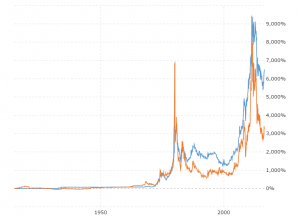The Fascinating History of US $1 Coins
In most countries around the world the basic unit of currency is a coin. Although it was once often a bill, inflation has taken its toll of the purchase value, making it more economically to use coins. Visitors often express some surprise to find the $1 bill still widely used in America, despite its low purchasing power. There have been numerous attempts to persuade the public to accept $1 coins, but they have all failed in one way or another.
The first $1 coin was the silver Morgan Dollar, minted from 1878 to 1904, and then again in 1921. It is named after its designer, George T. Morgan, who was an Englishman who came to America in 1876, and was responsible for numerous coin designs. His dollar features a profile head of Liberty on the obverse, and the American Eagle on the reverse.
Following WWI, there was pressure for a coin to commemorate the peace. Anthony de Francisci, a sculptor and coin-designer, modeled the head of Liberty for the Peace Dollar on his wife, Teresa, but his obverse design featuring a broken sword was the subject of huge public controversy. The design was modified and the coin was minted between 1921 and 1928, and again in 1934 and 1935.
Silver dollars tended to be kept in banks as bullion, except in the West, where they were popular in casinos. By the 1960s the value of silver had risen well above the face-value of the coins, and the Government withdrew them from the banks and the public through the issuing of silver certificates to replace their value.
It was 1971 before the next $1 coin was minted – known as the Eisenhower Dollar, with Dwight D. Eisenhower on the obverse. Because of the bullion price of silver by this time, the circulation coin was struck in copper, with nickel in the cladding to create a silver appearance. A collectors’ version made of 40% silver was also struck, and the coins were minted each year until 1978. Although the collector coins were popular, the circulation coins failed to circulate, and controversy swirled around the presence (or absence) of silver in this coins.
The next attempt to popularize $1 coins also became mired in dispute, and the Susan B. Anthony Dollar was only minted from 1979 to 1981, with an additional minting in 1999. Anthony was a prominent figure in the granting of the vote to women in America. The coin was unpopular, but it was useful in vending machines and public transit turnstiles.
By 2000 it was decided to release a new coin, the Sacagawea Dollar. In a break with tradition the coin was colored gold from a copper cladding, and became known as the ‘golden dollar’. Sacagawea was the Shoshone guide of the Lewis and Clark expedition. Despite an intense publicity drive, the coin again proved unpopular with the public.
In 2007 the Presidential $1 Coin Program began, but again, public demand was very small. Between 2012 and 2016 the coins were only released as collectors’ coins, and the Program has now ended. It is estimated that there may be 2 billion $1 coins lying in vaults, and right now there are no plans afoot to try again to interest the American public in doing what they clearly don’t want to do – use $1 coins.
With such a checkered history, these coins certainly do offer collectors an interesting area to collect. For example, Peace Dollars today sell for between $30 and $500, based on their relative rarity.








